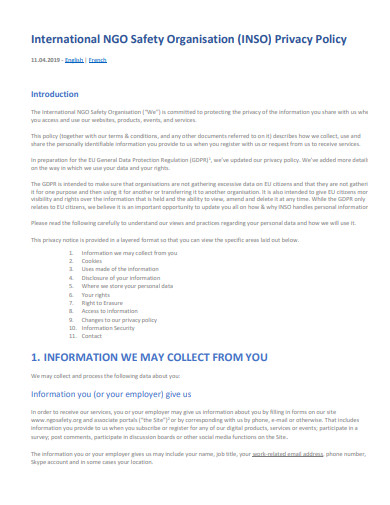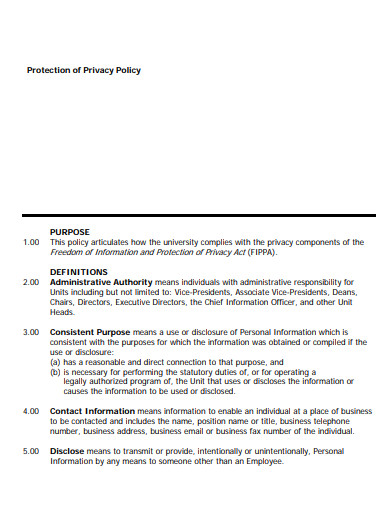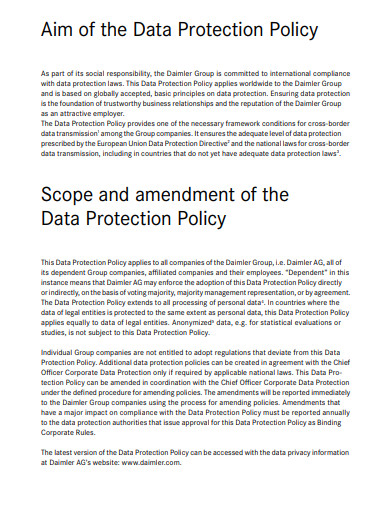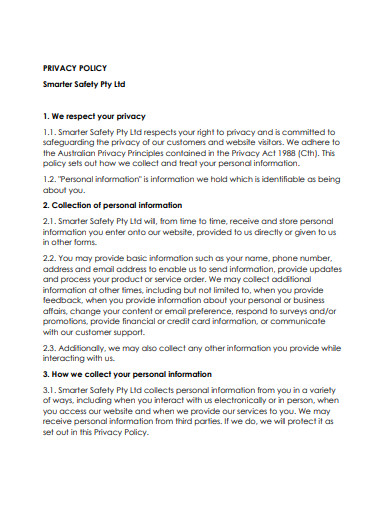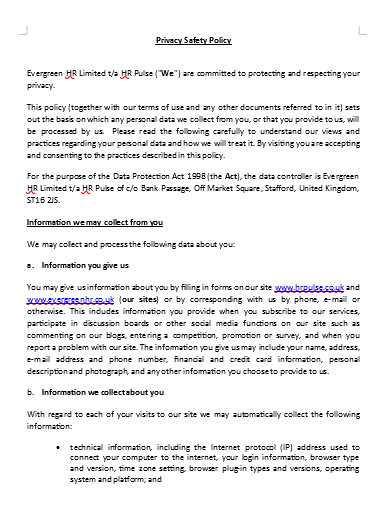Nowadays a lot of people’s information is being targeted and taken advantage of. Not just your personal information, but those owned by large companies and organizations as well. That is why it is so important to have a privacy and safety policy. With a well written one it can ensure that people take steps to safeguard their information and avoid any trouble.
[bb_toc content=”][/bb_toc]
4+ Privacy and Safety Policy in PDF | MS Word
If you need some help on starting a privacy and safety policy, take a look at our templates to get some ideas! We have several kinds that are tailored specifically for what you need.
1. privacy and safety policy
2. Sample Privacy and Safety Policy
3. Data Protection Privacy and Safety Policy
4. Simple Privacy and Safety Policy
5. Basic Privacy and Safety Policy
What is a Privacy and Safety Policy?
A privacy and safety policy refers to an organization’s set of rules and regulations when it comes to the protection of the information they keep. This information could refer to their work, finances, and plans. Making a policy essentially gives the group a way to practice keeping security in the event that someone would try a security breach. Its contents contain statements on how a company or organization collects and stores their information all in order to keep it confidential.
How to Write a Privacy and Safety Policy?
According to a recent study by Statista as of 2019 about 7% of the United States are very aware of cyber security while 26% are somewhat aware and 33% are not. This goes to show how important it is to do a coherent and well written write up of your own privacy and safety policy. To get started keep reading this article and find out what you can do.
1. Use the Right Words at the Right Time
Write your policy in an easy and understandable way. Try to use simple words so that your readers won’t have a hard time reading it. That being said use the right terminology when you are mentioning details such as legal and security terms. With a well written policy you will be able to provide your company with a set of rules that will help them protect their information and limit the access to it. Take the time to double check for grammar and spellings as well, as an error in that regard can really put off your readers.
2. Be Transparent
For an effective privacy and safety policy you need to be as transparent as you can with your readers. Let your audience know what happens to their information and how you are collecting it. Write down what you are going to do with that information and how you are going to process it as well.
3. Fact Check Your Statements
Always check your statements when it comes to writing your privacy and safety policy. This ensures that you are providing the right kind of information to your audience while at the same time not putting your company through any risk to their information. Take some time to do some research and make sure what you have written is correct. Consult with an expert in law so that your policy meets the legal standards.
4. Write Down Laws and its Consequences
Suppose you grant access to certain information that is private, you must make sure your policy ensures it is kept safe. Make sure that your policy is in line with laws that ensure its protection. You can also include the consequences if they fail to follow them. List out the legal actions that can be taken if a person chooses to ignore what is being stated by the policy.
5. Specify What It Is You Are Protecting
Don’t leave your privacy and safety policy all vague. State exactly what it is your policy is going to protect right away when you present it to your readers. Whether it be their personal information, their identity, or whatever they are going to share. That way it is legally binding and the person can share it in confidence. This part is actually a legal requirement to add when making a privacy and safety policy.
FAQs
Can I use some other company’s privacy and safety policy?
No you can’t. Privacy and safety policies are copyrighted documents. This means you are not allowed to copy them and present them as your own. You will have to make your own unique policies. The best thing you can do is use them as a reference and do your own research to make your ideal privacy and safety policies.
What makes privacy different from security?
The purpose of security and privacy tends to overlap. While they appear to have the same meaning they both have a big difference. Privacy protects the identity of the user, while security is about safeguarding data and information.
How are security and privacy connected?
Privacy is about the protection of someone’s personal information. Meanwhile, security is about safeguarding access of information and keeping things confidential. Both are connected by the way information flows regarding these two.
Is it a requirement to have a privacy and safety policy?
Based on state and federal laws there isn’t any law that says a company should have one exactly. However there are several laws that exist where having a privacy and safety policy is a way of obeying it. To be on the safe side one should just have one anyway in order to avoid any problems in the later future.
According to an article by Forbes data privacy has become a cultural and social issue of the decade. With security breaches and data leaks being central to a lot of infamous scandals. This is why it is vital that privacy and safety policies are written to the letter strongly in order to avoid any issues like that in the near future. Information can be very dangerous in the wrong hands so while policies are kept in place, take an active role as well in safeguarding your privacy and keeping your information safe.


